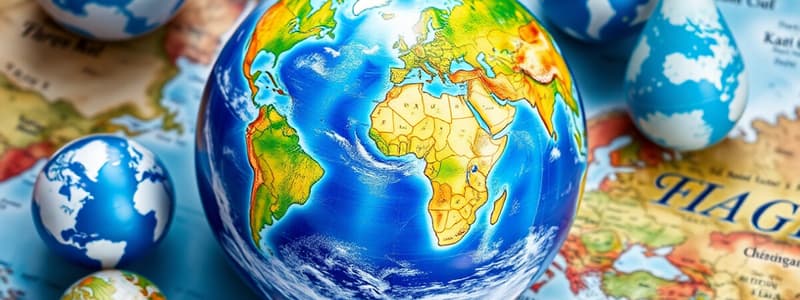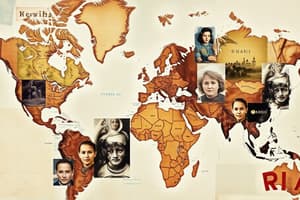Podcast
Questions and Answers
What are the four themes of geography?
What are the four themes of geography?
- Distribution Patterns (correct)
- Regional Landscape (correct)
- People-Environment Relationship (correct)
- Cultural Studies
Which of the following are types of maps? (Select all that apply)
Which of the following are types of maps? (Select all that apply)
- Political Map (correct)
- Climate Map (correct)
- Physical Map (correct)
- Historical Map (correct)
- Road Map (correct)
What layers comprise the spheres of the Earth?
What layers comprise the spheres of the Earth?
- Lithosphere (correct)
- Biosphere (correct)
- Hydrosphere (correct)
- Astronosphere
What is the significance of climate graphs?
What is the significance of climate graphs?
What are the types of plate boundaries?
What are the types of plate boundaries?
The three major rock types are: Igneous, ______, and Metamorphic.
The three major rock types are: Igneous, ______, and Metamorphic.
All types of maps contain a title.
All types of maps contain a title.
What are key lines of longitude?
What are key lines of longitude?
What is an example of glacial erosion?
What is an example of glacial erosion?
Which process describes the movement of tectonic plates towards one another?
Which process describes the movement of tectonic plates towards one another?
The hydrosphere includes all the water on Earth, including water vapor in the atmosphere.
The hydrosphere includes all the water on Earth, including water vapor in the atmosphere.
What term describes the relationship between people and their environment in geography?
What term describes the relationship between people and their environment in geography?
A __________ map emphasizes the spatial distribution of various features, such as populations and resources.
A __________ map emphasizes the spatial distribution of various features, such as populations and resources.
Match the following geological structures with their descriptions:
Match the following geological structures with their descriptions:
Which climate characteristic is described by the acronym L.O.W.E.R.N?
Which climate characteristic is described by the acronym L.O.W.E.R.N?
Name one type of destructive force in geology.
Name one type of destructive force in geology.
Flashcards are hidden until you start studying
Study Notes
Key Terms & Definitions
- Define all key terms from the provided "Keys Terms Sheet" focusing on introductory concepts and physical interactions.
What is Geography?
- Geography encompasses four key themes: people-environment relationships, regional landscapes, distribution patterns, and changing geographic patterns.
Map Types
- Identify and understand the characteristics of at least five different map types (e.g., topographic, thematic, choropleth, etc.).
Map Components
- Familiarize yourself with essential map components: title, border, legend, scale, compass rose, and key lines of latitude and longitude. Understand how to interpret each.
Earth's Spheres
- Understand the four main spheres of the Earth: lithosphere (land), hydrosphere (water), biosphere (life), and atmosphere (air). Be able to describe their interactions.
Atmosphere Layers
- Know the different layers composing the atmosphere (e.g., troposphere, stratosphere, etc.) and their key characteristics.
Geological History & Plate Tectonics
- Understand the concept of plate tectonics and its evidence (fossils, landforms, climate).
- Describe the three main types of plate boundaries: transform, divergent, and convergent (including subduction).
- Differentiate between constructive and destructive forces shaping the Earth's surface.
Glaciation & Erosion
- Explain the impact of glaciation and glacial erosion on landforms.
Rock Cycle
- Understand the rock cycle and the processes involved in the formation of igneous, sedimentary, and metamorphic rocks. Be prepared to interpret a diagram.
Landform Regions
- Be familiar with major landform regions and the processes that create them.
Weather & Climate
- Differentiate between weather and climate.
- Understand the factors influencing climate (consider the acronym L.O.W.E.R.N. if provided in class materials).
Climate Graph Interpretation
- Be prepared to calculate and interpret data from climate graphs.
Short Answer Preparation
- Anticipate short answer questions requiring in-depth explanation of concepts covered above. Practice applying your knowledge to hypothetical scenarios or specific examples.
Key Terms
- Review the key terms sheet for definitions and understanding of introductory concepts and physical interactions.
What is Geography?
- Geography has four main themes: People-environment relationships, regional landscapes, distribution patterns, and changing geographic patterns.
Map Types
- Study the five types of maps and their characteristics (e.g., topographic, thematic, choropleth).
Map Parts
- Understand the function and importance of map components: title, border, legend, scale, compass rose, and grid system (latitude and longitude).
Key Lines of Latitude and Longitude
- Know the equator and prime meridian, and how latitude and longitude coordinates pinpoint locations.
Earth's Spheres
- Earth’s systems: lithosphere (solid rock), hydrosphere (water), biosphere (living things), and atmosphere (gases). Study the layers of the atmosphere.
Geological History and Plate Tectonics
- Understand the basics of plate tectonics, including the evidence (fossils, landforms, climate) supporting it.
- Know the types of plate boundaries (transform, divergent, convergent, including subduction), constructive and destructive forces, and resulting landforms.
- Review the rock cycle and the three rock types: igneous, sedimentary, and metamorphic.
- Understand and interpret glacial erosion and the associated landforms.
- Be familiar with various landform regions.
Weather and Climate
- Understand the difference between weather and climate.
- Learn the characteristics of climate using the LOWERN mnemonic (Latitude, Ocean Currents, Winds, Elevation, Relief, Nearness to Sea).
Climate Graphs
- Practice interpreting and calculating data from climate graphs.
Studying That Suits You
Use AI to generate personalized quizzes and flashcards to suit your learning preferences.



